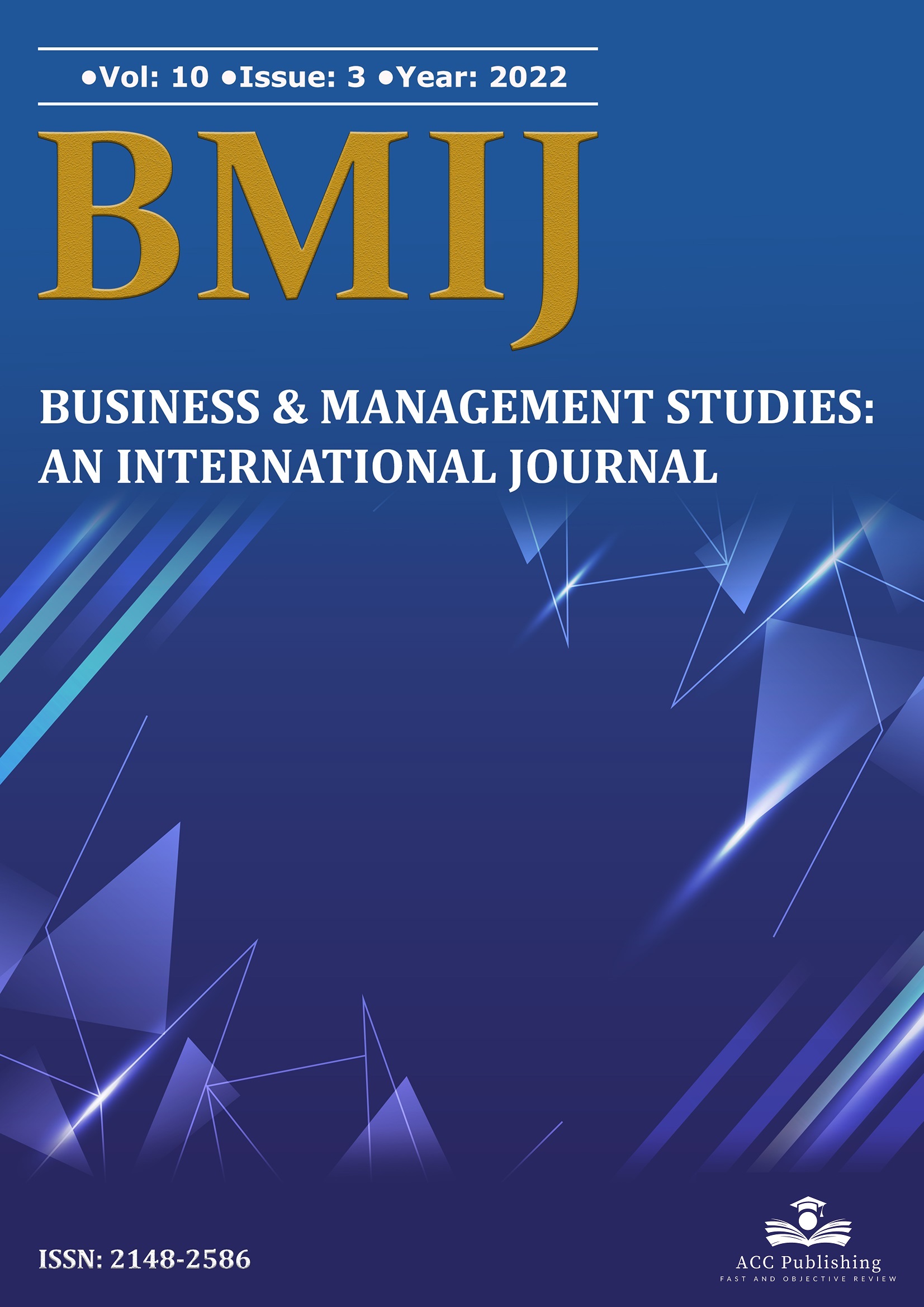The effect of organizational justice on organizational productivity: A study on the public sector

Published 2022-09-25
Keywords
- Örgütsel Adalet, Verimlilik, Kamu Çalışanları
- Organizational Justice, Efficiency, Public Employees
How to Cite
Copyright (c) 2022 Alper Bahadır DALMIŞ

This work is licensed under a Creative Commons Attribution-NonCommercial-NoDerivatives 4.0 International License.
Abstract
In the competitive market conditions of the globalizing world, productivity is essential for organizations. In order to ensure and maintain efficiency, various conditions must be met in organizations. The organizational justice perception of the employees is one of these conditions. It is thought that when employees think that the organization is fair to them, they can work more efficiently by feeling a moral responsibility. This situation can increase organizational efficiency. This study it is aimed to examine the effect of organizational justice on productivity. In this direction, the employees in a public institution in Ankara constituted the universe of the study. The study sample comprises 278 people (117 women and 161 men). Demographic Information Form, Organizational Justice and Productivity Scale were used to collect data. Correlation and regression analysis was applied in the statistical analysis of the data collected from the scales. Findings revealed that employees' perceptions of organizational justice are associated with productivity. In addition, it was determined that the dimensions of distributive justice, procedural justice and interactional justice, which are the sub-dimensions of organizational justice, have a statistically significant and positive relationship with productivity. Therefore, it has been concluded that employees' perceptions of organizational justice and its sub-dimensions increase organizational productivity. In this direction, it is recommended that managers and other decision-makers in organizations gain awareness of organizational justice.
Downloads
References
- Alexander, S., & Ruderman, M. (1987). The role of procedural and distributive justice in organizational behavior. Social justice research, 1(2), 177-198.
- Bağcı, Z. (2014). Çalışanlarin İş Doyumunun Görev ve Bağlamsal Performansları Üzerindeki Etkisi. Journal of Management and Economics Research, 12(24), 58-72.
- Bölük, U. (2017). İnsan kaynakları yönetiminde örgütsel adaletin verimlilik ve iş tatmini üzerine etkisi: Bir kamu kurumu örneği (Master's thesis, İstanbul Gelişim Üniversitesi Sosyal Bilimler Enstitüsü).
- Çağıl, E. (2007). İşletmelerde personel eğitimi, verimlilik ile ilişkisi ve bir araştırma (Doktora Tezi, Marmara Universitesi, Istanbul, Türkiye.
- Choudhary, N., Philip, P. J., & Kumar, R. (2011). Impact of organizational justice on organizational effectiveness. Industrial Engineering Letters, 1(3), 18-24.
- Cojuharenco, I., & Patient, D. (2013). Workplace fairness versus unfairness: Examining the differential salience of facets of organizational justice. Journal of Occupational and Organizational Psychology, 86(3), 371-393.
- Folger, R., & Konovsky, A. M. (1989) “Effects of Procedural justice and Distributive Justice on reaction to Pay raise Decision,” Academy of Management Journal, 32(1), 115-130.
- Fryxell, E.G., & Gordon, E.M. (1989) “Work place Justice and Job Satisfaction as predictor of satisfaction with Union and Management,” Academy of Management Journal, 32(4), 851-866.
- Goodman, S. A., & Svyantek, D. J. (1999). Person–organization fit and contextual performance: Do shared values matter. Journal of vocational behavior, 55(2), 254-275.
- Greenberg, J. (1986). Determinants of perceived fairness of performance evaluations. Journal of applied psychology, 71(2), 340.
- Greenberg, J., & Tyler. R. T. (1987), “Why Procedural Justice in Organizations? ,” Social Justice Research, 1(2), 127-142.
- Hançer, M. (2004). İşletmelerde verimliliği artırma ve insan kaynakları. Detay Yayınları.
- Homans, G. C. (1961). Social Behavior: Its Elementary Forms, Brace & World. Inc.. New York^ eHarcourt Harcourt.
- Kalay, F. (2016). İşletmelerde Örgütsel Adaletin İşgören Performansi Üzerindeki Etkisi: Teorik Bir İnceleme. Kastamonu Üniversitesi İktisadi ve İdari Bilimler Fakültesi Dergisi, 11(1), 147-158.
- Kocaçal, C. (2016). İşletme çalışanlarında pozitif ve negatif düşüncenin işgücü verimliliğine etkisi: İstanbul ili örneği (Master's thesis, Sosyal Bilimler Enstitüsü).
- Lind, E. A., & Tyler, T. R. (1988). Procedural justice in organizations. In The social psychology of procedural justice (pp. 173-202). Springer, Boston, MA.
- Lowe, R. H., & Vodanovich, S. J. (1995). A field study of distributive and procedural justice as predictors of satisfaction and organizational commitment. Journal of business and psychology, 10(1), 99-114.
- Mızrak, N. Y. (1991). işletmelerde Verimliliğe Yönelik Eğitimin Önemi: Türk Özel Sektörü Tarafından Yapılan Eğitim Çalışmaları. Verimlilik Kongresi-Bildiriler içinde: ay (der.) Ankara: MPM Yayınları, 454, 27-29.
- Moorman, R. H. (1991). Relationship between organizational justice and organizational citizenship behaviors: Do fairness perceptions influence employee citizenship?. Journal of applied psychology, 76(6), 845.
- Niehoff, B. P., & Moorman, R. H. (1993). Justice as a mediator of the relationship between methods of monitoring and organizational citizenship behavior. Academy of Management journal, 36(3), 527-556.
- Organ, D. (1988).Organizational Citizenship Behavior: The Good Soldier Syndrome. Lexington, MA: Lexington.
- Rego, A., & Cunha, M. P. E. (2008). Organisational citizenship behaviours and effectiveness: An empirical study in two small insurance companies. The Service Industries Journal, 28(4), 541-554.
- Usta, P. (1996). Verimlilik, Verimlilik Artırıcı Teknikler, Verimlilik Artırıcı Tekniklerin Daha Yaygın Kullanılması İçin Tedbirler. Akçimentosa Aylık İletişim Dergisi, 9.
- Yıldırım, F. (2007). İş doyumu ile örgütsel adalet ilişkisi. Ankara üniversitesi sbf dergisi, 62(01), 253-278.


